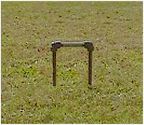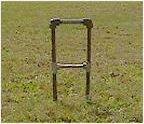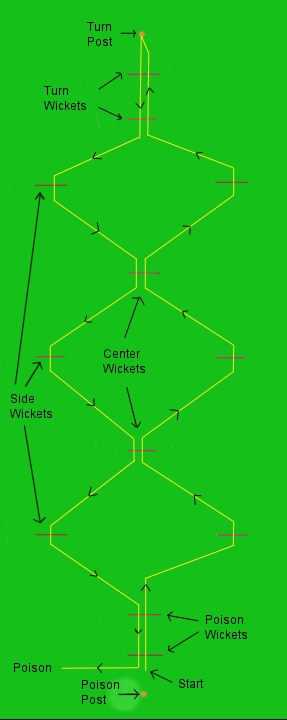 Featuring eXtreme croquet and eXtreme croquet mallets.
Featuring eXtreme croquet and eXtreme croquet mallets.

 Dedicated to enjoying eXtreme croquet, nature, and the near-death experience!™
Dedicated to enjoying eXtreme croquet, nature, and the near-death experience!™






















Legal


|
 |


HOW TO SET UP AND PLAY


Mallets:
Our mallets are specially designed with a wedged face and machined for extreme play, which means they are able to take serious punishment under the worst conditions of terrain and weather.
Our mallets are made of 3.25-inch Polycarbonate with 1.125 inch birch shafts, pinned completely through the head and shaft with 0.25-inch steel rod, then glued with golf-shaft epoxy (many name brands out there). The Polycabonate is much tougher than wood, as we found over the years of development.
Normally tough woods like iron wood, hornbeam, oak, etc. shatter in practically no time. Only the polycarbonate heads survived. Actually, we used to make them out of aeronautical grade 6/6 Nylon, but even they have been known to chip in the 20-degree January 1 New Year's Championship (played at 12:01 AM every New Year's eve).
Polycarbonate is noted for being literally bullet-proof. It is used in helmet material, bullet-proof vests and other assorted highly survivable objects.
It is way cool - the heads are transparent and really high-tech looking. We have totally switched over to using Polycarbonate in our mallets.
We have broken a couple of the birch shafts, but again only under the most unusual of circumstances. We are in the process of trying metal prototypes, in both shaft and head designs. Maybe polymeric liquid-crystal carbon-fiber next !!!
Balls:
We still use wooden balls whenever we can get them, except in the winter when good plastic polymer balls are necessary. The wooden balls tend to shatter in the dead of winter. It is not at all unusual to shatter a ball anytime during eXtreme play. Have an extra ball or two available in the event of a shatter.
Wickets:
We have three different wickets for specific uses on our courses.
Regular Wickets
All wickets except the turn wickets and the center wickets are 0.5-inch steel pipe (not cast iron plumbing pipe: that snaps off after a few games when getting hit by the sledge hammers) with welded high-pressure steel elbows connecting the pieces. They are very heavy, and we are trying to come up with new ideas that might work. The beauty of them, however, is that it is possible to slam balls into them with amazing strength and get great caroms. The wickets themselves are six inches across the top and twelve inches long. This gives a reasonably large target, which are needed and appreciated in the courses we play.



Center Wickets
The second type of wicket we use is the center wicket (we actually use two of them, since we play a twelve-wicket course). These are also 0.5-inch steel pipe, but they are double-tiered wickets. We use the regular twelve-inch pipe for the sides, but instead of an elbow connecting the pipes, we use a T-connection. The second tier of the wicket is eight-inch steel pipe, again connected with high-pressure steel elbows at the top. The reason for this type of wicket is simple: if a player hits through the bottom tier, he/she would get one shot; should the player hit through the top tier, he/she would get two shots. This is one reason to used wedged mallets.
Turn Wickets
The third type of wicket we use is for the turn, where, hopefully, there will be constant interaction between the players. These are standard competition wickets ... very narrow ... very difficult. When these wickets are combined with the great length between the two turn wickets and the general problems of terrain, you get players clumped at the turn, roqueting each other down hills and into streams. 
 New Wickets Developed
New Wickets Developed
Wicket development has recently undergone some unexpected and very radical change.
Our old wickets were made out of steel pipe (described above) and were very functional and rugged ... but they were also very heavy and way too cumbersome. It was a real chore just to carry them around. Just as we figured we were doomed to horse-pull them around to every course, our Black Box guy - Bruce - came up with a totally new and creative wicket material ... Lightning Rods ... yes, lightning rods !!!
Lightning rod material is essentially a copper-plated zinc rod (obviously for good conductivity) that is very tough and rigid. It is also very light compared to the steel pipe configuration. In fact, they are so tough, Bruce had to take them to a machinist to have them machine bent and tooled. You won't be able to bend these puppies at home!
We made them the same dimesions as our old steel wickets. However, the center wickets are actually two wickets - a short and a long wicket bound together to make the double-high center wickets.
You can see nice pictures of the old vs. new here.
The wickets are quite pretty, and turn a beautiful verdigris green as they age and oxidize. Coat them with several coats of clear spray polyurethane if you want them to stay copper colored longer. Just don't play in a thunderstorm. We're not sure that we want to play in the rain anymore !!!
Get the material at Home Depot, but be prepared - it's not cheap.
If nothing else, we don't have to have a team of draft horses to haul them to the games.
Posts:
Our posts are made of 1.25-inch steel rod, machined to a point at one end. As with all of our equipment,this is necessary due to the harsh conditions found not only in frozen winter ground, but in the rocky fields and state park areas where we play. We carry a five-pound sledge with us for setting both the posts and wickets.
Layout:
The layout of a course ... or how and where you place your wickets and posts ... can be the thing that makes or breaks your game.
Start Wickets:
The first two wickets should be placed as close together as possible, to make the finish as difficult as possible for potential poison players. This usually means that the first wicket is placed about 10-12 inches from the post, and the second wicket equally far from the first one.
Corner or Side Wickets:
The corner wickets (six in our game, as we have two center wickets) are set anywhere on a course where terrain demands they be put, either aesthetically or competitively. Too long is bad, both for the game and the equipment. You lose the "touch" factor, and are more apt to break equipment.

Center Wickets:
We use double-tiered wickets for the center wickets. The first center wicket should be placed so that a player positioned at that wicket will have a playable shot towards the poison wickets. This is important in the end game where one player is too far ahead. It also makes the scoring more interesting because one can set up at the wicket to go for a score of eight points for a post assassination. Usually a shot of about 30 feet is a good length, depending on terrain.
Turn Wickets:
We have the turn wickets spaced in relation to the terrain. In a long, flat course, the turn wickets will be as much as twenty or more feet apart. In a shorter, rougher course, like in a wooded park, the turn wickets could be as little as five feet apart. This is to facilitate the clumping of players at the turn, bringing into play a lot of the strategy of ball choice (Rule 2.30). The more interaction at the turn the better. This is the part of the course where the ball choice rules really change the face of the game strategy. It makes it extremely difficult to make a "safe" shot.
We alternate between starting left and starting right just to give the games more variety.
Courses:
Normally (what ever that means) we pick very difficult courses. But we use different courses in different weather, or different courses depending how we feel that particular day.
Fields
Fields offer courses that are a great place to start playing eXtreme croquet. They are a little more difficult than a backyard, yet they let the newcomer try something a little more daring, but at the same time, a little bit familiar and non-intimidating.
Just be sure you have permission, and don't trample a farmers field of wheat or hay crop. Fallow fields, harvested fields, or pastures are best. Try a harvested corn field for some real fun.
Parks
Parks provide great venues for eXtreme croquet. They are open to all users, they are well maintained, and can provide a whole range of terrains ... from easy to eXtreme.
We usually choose areas away from the populated areas. This is NOT because we are shy, but because the curious onlookers are not there, not in the way, and out of danger's reach.
We enjoy the near-death experience, but we're not sure about them.
Drainage basins
Drainage basins provide some of the best combinations of interesting and at the same time difficult terrain. These sites can really be eXtreme. They have coarse grasses and shrubby stuff, holes and bumps, rip-rap, water, mud, sand, gravel and rocks, steep grades and drop-offs as well as flat, well managed areas around them. They can provide a real test and callenge to your game. These are among our favorite courses.
Woods
Wooded areas can provide some of the most challenging courses around ... especially if you can find woods with stream beds, ravines, lots of downed trees, rocks and boulders, railroad tracks and other terrain. Try a course set at 75 - 80 yards for a real challenge !!
Courses are never measured. We use courses that range from about 50 yards in winter, up to about 80 yards in regular weather. Our average course length is probably 75 yards, although we have played up to 125-150. We don't play that far anymore because that kind of distance takes out the "touch" factor. One of our courses, "The Pit", is about 60 yards from post to post. Wharton Brook Park is usually about 80 yards.
We almost always place the wickets where the terrain demands them to be. We DO NOT place wickets at measured distances. The distance from wicket to wicket can be anything from 10/15 yards to 40/60 yards.
It is very common for for us to make a right angle turn in the middle of the course, like a dog-leg. This adds to the total complexity, and makes the course even more interesting. Sometimes the courses will look downright lop-sided. You should always follow the terrain. Keep in mind it's quality, not quantity.
If we find a group of trees, we put the wickets where the trees provide a natural barrier to their access ... in other words we make sure the trees are in the way. We put the wickets in places where, if you over-shoot the shot by three feet, you drop off a ledge or steep grade. We make sure there's a stump in the way, or a stream bed with water in it. Railroad tracks are particularly gruesome. Just try to use any hindurance or obstruction to make the game its most challenging.
Ask yourself ... are you scared, or do you want to play eXtreme?

Home |
Intro |
Playing |
Rules |
Gallery |
Articles |
Mallets |
News |
Contact |
Links
Copyright © 2000 - 2020 by
Connecticut eXtreme Croquet Society
All rights reserved
|

|
|
|

